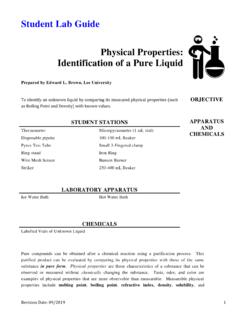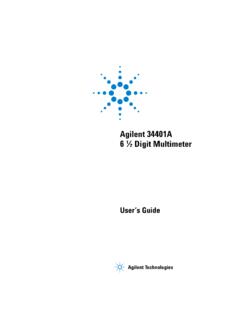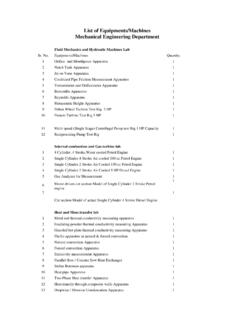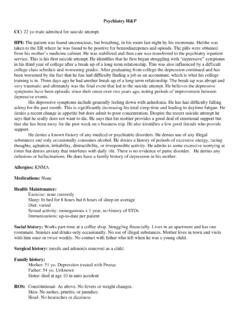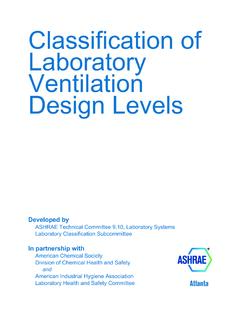Transcription of The Decomposition of Hydrogen Peroxide - Chem21Labs
1 E x p e r i m e n t The Decomposition of Hydrogen Peroxide 13. Objectives To determine the general rate law of a reaction. To determine the rate constant for a reaction. To determine the activation of a reaction from two trials or multiple trials. To understand the functions and properties of catalysts. To understand dilution calculations. To convert between mass percent and molarity. In the Lab Students will work in pairs. Waste Solutions can be washed down the drain with excess water. Safety The stopper in the test tube may pop out if the pressure raises enough. Do not point it at yourself or others. 65 . E x p e r i m e n t 1 3 The Decomposition of Hydrogen Peroxide Any molecule in motion possesses kinetic energy, and Factors Influencing the Reaction Rate the faster it moves, the greater the kinetic energy it has.
2 The rate at which the reaction occurs depends on several When molecules collide, some of the energy is converted factors: into vibrational energy. If the vibrational energy is large, it may cause some of the chemical bonds in the molecule 1. the nature of the reaction to break. Breaking bonds is the first step towards product formation. If the initial kinetic energies are small, the 2. the concentration of the reactants molecules will merely bounce off each other without breaking any bonds. In order to react, the molecules 3. the temperature of the reaction must have a total kinetic energy equal to, or greater than, the activation energy, Ea. The activation energy is 4. the presence of a catalyst the minimum amount of energy required to initiate a chemical reaction. The change in concentration and temperature affect the rate of a chemical reaction by influencing the collisions The energy change in a reaction is given on an energy- among the molecules.
3 An increase in concentration in- level diagram, or potential energy profile, as shown in creases the number of molecular collisions. An increase Figure The vertical axis gives the potential energy in temperature increases the rate because the molecules for the reaction, while the horizontal axis is a relative ( , move faster, increasing the kinetic energy and collisions time) scale that shows the progress of the reaction. The are more frequent. diagram indicates that there is a hill or energy barrier that needs to be overcome before any products can be A catalyst is a compound that affects the rate of Expt. 13. formed. If the collision between the molecules produces chemical reactions by lowering the activation energy, enough energy to overcome the barrier, the reactant Ea. With a lower activation energy, less energy is needed molecules are in a temporary transition state, forming to overcome the energy barrier to form the product(s).
4 A. an activated complex at the height of the barrier before catalyst takes part in the reaction, but is not consumed. forming the product molecules. It always returns to its original composition at the end Activated complex of the reaction. Catalysts are defined as homogeneous or heterogeneous where the catalyst is either in the same phase as the reactants or in a different phase, r espectively. Ea Reaction Rate and Rate Laws Relative Energy Consider a chemical system in which there are two re- actants, A and B, with stoichiometric coefficients a and Reactants b, forming c moles of product C. Hrxn aA bB cC. Products The rate of the reaction can be defined as the change Progress of Reaction in concentration of the product as a function of the change in time: Hayden-McNeil, LLC. Figure Energy diagram of a reaction.
5 D [C]. rate . Dt 66. E x p e r i m e n t 1 3 The Decomposition of Hydrogen Peroxide . Although the rate of the reaction is constant under the If the concentration of the reactant triples . conditions we set, we can vary it between trials by chang- then the reaction is ___. ing the initial concentrations of the reactants. For a given and the initial order with respect to that reaction, the rate typically increases with an increase in reactant. the concentration of a reactant. For our general reaction, triples (31) first the relationship between the rate and the concentration of the reactants is given by the rate law increases nine-fold (3 ) 2. second Decomposition of Hydrogen Peroxide Rate k [A]m [B]n The Decomposition of Hydrogen Peroxide in aqueous solution proceeds very slowly. A bottle of 3% Hydrogen In this rate law equation, k is a constant, called the Peroxide sitting on a grocery store shelf is stable for a long rate constant of the reaction and should be the same period of time.
6 The Decomposition takes place according for trials of the reaction at a given temperature. The to the reaction below. superscripts, m and n, are the order of the reaction with respect to A and B and are integers, such as 0, 1, 2, or 3. 2 H2O2(aq) 2 H2O O2(g). The values of m and n do not come from the coefficients of the balanced chemical equation, although they may A number of catalysts can be used to speed up this reac- occasionally have the same value. For example, if m is tion, including potassium iodide, manganese (IV) oxide, 1, the reaction is said to be first order with respect to and the enzyme catalase. If you conduct the catalyzed reactant A. The sum of orders ( , m n) is the overall Decomposition of Hydrogen Peroxide in a closed vessel, order of the reaction. The order of a reaction must be Expt.
7 13. you will be able to determine the reaction rate as a func- determined experimentally and cannot be determined tion of the pressure increase in the vessel that is caused from the chemical equation alone. by the production of oxygen gas. If you vary the initial molar concentration of the H2O2 solution and the catalyst Determining the order of the reaction must be done (KI) concentration, the rate law for the reaction can also using experimental data. Pairs of trials can be com- be determined. Finally, by conducting trials at different pared that vary only the concentration of one reactant. temperatures with the same concentrations, the activa- If changing the concentration of that reactant causes tion energy, Ea, can be calculated. a change in the rate, then we can say that the rate is dependent to some degree on the concentration of that Mass Percent and Molarity species.
8 Conversely, if the rate does not change with the The initial concentration of the Hydrogen Peroxide is change in concentration of one of the reactants, the rate given as 3% by mass. In order to determine the rate is not dependent on the concentration of that species. constant for this reaction, you'll need to convert the concentration into molarity. If the concentration of the reactant doubles . then the reaction is ____ moles of solute Molarity . and the initial rate order with respect to that L of solution reactant. mass of solute Mass percent * 100. doubles (21) first total mass of solution quadruples (22) second Since both molarity and mass percent are concentration increases eight-fold (2 ). 3. third units, it just takes a few steps to convert one to another, using the molecular weight of the compound and the density of the solution.
9 Since the solutions in this ex- periment are dilute aqueous solutions, we will assume a density of g/mL for the H2O2 solution, which is the density of water. 67 . E x p e r i m e n t 1 3 The Decomposition of Hydrogen Peroxide Example: What is the molarity of an 85% (by mass) H3PO4 n v is in units of mol/L, which is the molarity of the solu- solution ( = g/mol, d= g/mL)? (An 85% tion, so we can write solution of phosphoric acid would not be a dilute aqueous solution so the actual density of the solution is needed.) P. M . RT. g H 3 PO 4 1 mol Molarity = . 100 g solution g H 3 PO 4 where M is the molarity. Divide both sides by seconds, g H 3 PO 4 1000 mL which will result in the molar rate constant . mL solution 1L. M P. M s The reverse calculation, from molarity to mass percent, is s . RT. also possible.
10 We find P/s from the graph and use the above formula Dilutions to find the rate in M/s. One concentration of KI and H2O2 is available for you to use. In order to determine the rate law, we must vary the Looking at the units, you should see concentration of both species. We can prepare solutions of lower concentration through dilution. The dilution torr mol s formula Ls . L torr e oK. K mol MiVi MfVf Expt. Prove to yourself that these are equal. 13. can only be used for dilution calculations. Do not use this formula for titration calculations. Mi and Mf are the Make sure you use the correct value of R in the equation concentrations and Vi and Vf are the volumes of the L atm 760 torr L torr initial and final solutions, respectively. The units for this e oe o mol K 1 atm mol K. formula are not specified, you just need the same units for Mi and Mf and the same units for Vi and Vf.

